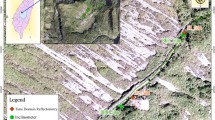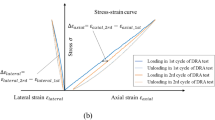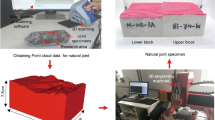Abstract
In this study, time domain reflectometry (TDR) is engaged to observe coaxial cable deformity caused by slope movements. Laboratory shear tests were executed to measure the deformity magnitude caused by shear failure using two coaxial cables—RG-6 and RG-213. Two assessments are performed in laboratory testing, to determine the deformity magnitude—shear test and open-cast (OC) model. For shear test, two regression methods are computed—linear and quadratic regression. The quadratic regression results show more effective positive correlation with shear deformity as compared to linear regression results. For RG-6 and RG-213 cables, the average highest magnitude of coaxial cable deformity by shear failure is 11 mm and 14 mm, respectively, which are equivalent to reflection coefficient (RC) of 0.49 and 0.050 for RG-6 and RG-213, respectively, beyond which the cable breached. Field tests are also performed, which concluded that TDR is the most preferable technique to monitor slopes of OC mines.





Similar content being viewed by others
REFERENCES
O’Connor, K.M. and Dowding, C.H., Geomeasurements by Pulsing TDR Cables and Probes, CRC Press, 1999.
Dowding, C., Su, M.B., and O’Connor, K., Measurement of Rock Mass Deformation with Grouted Coaxial Antenna Cables, Rock Mech. Rock Eng., 1989, vol. 22, no. 1, pp. 1–23.
Wahab, N.S.M.A. et al., Potential of Time Domain Reflectometry as Early Warning System in Slope Stability Monitoring Project: A Review,AIP Conf. Proc., Penang, Malaysia, 2016.
Kane, W.F., Beck, T.J., and Hughes, J.J., Applications of Time Domain Reflectometry to Landslide and Slope Monitoring, Second Int. Symp. and Workshop on Time Domain Reflectometry for Innovative Geotechnical Applications, Evanston, USA, 2001.
Drusa, M. and Bulko, R., Rock Slide Monitoring by Using TDR Inclinometers, Civ. Environ. Eng., 2016, vol. 12, no. 2, pp. 137–144.
Yadav, D.K., Guntha, K., Singam, J., and Das, S.K., Design of Real-Time Slope Monitoring System Using Time-Domain Reflectometry with Wireless Sensor Network, IEEE Sensors Lett., 2019, vol. 3, no. 2, pp. 1–4.
Su, M.B. and Chen, Y.J., TDR Monitoring for Integrity of Structural Systems, J. Infrastruct. Syst., 2000, vol. 6, no. 2, pp. 67–72.
Dowding, C.H., Dussud, M.L., Kane, W.F., and O’Connor, K.M., Monitoring Deformation in Rock and Soil with TDR Sensor Cables,Geotech. News, 2003, vol. 21, no. 2, pp. 51–59.
Dowding, C.H. and Huang, F., Early Detection of Rock Movement with Time Domain Reflectometry, J. Geotech. Eng., 1994, vol. 120, no. 8, pp. 1413–1427.
Chen, R., Drnevich, V.P., Yu, X., Nowack, R.L., and Chen, Y., Time Domain Reflectometry Surface Reflections for Dielectric Constant in Highly Conductive Soils, J. Geotech. Geoenvironmental Eng., 2007, vol. 133, no. 12, pp. 1597–1608.
Skierucha, W., Wilczek, A., Szyplowska, A., Slawinski, C., and Lamorski, K., A TDR-Based Soil Moisture Monitoring System with Simultaneous Measurement of Soil Temperature and Electrical Conductivity, Sensors (Switzerland), 2012, vol. 12, no. 10, pp. 13545–13566.
Lin, C.P., Tang, S.H., Lin, W.C., and Chung, C.C., Quantification of Cable Deformation with Time Domain Reflectometry Implications to Landslide Monitoring, J. Geotech. Geoenvironmental Eng., 2009, vol. 135, no. 1, pp. 143–152.
Singer, J., Festl, J., and Thuro, K., Application of Time Domain Reflectometry (TDR) as a Monitoring System for Subsurface Deformations, Geol Act., 2010, pp. 2459–2465.
Bin, Lu W., Fu, H.L., and Tan, H.H., Study on Application of Time Domain Reflectometry to Highway Slope Monitoring, Advanced Materials Research, 2011, vol. 230, pp. 1375–1378.
Kane, W.F., Monitoring Slope Movement with Time Domain Reflectometry, Geotech. F. Instrum. Appl. Eng. Geol., 2000.
Bin, Su M., Chen, I.H., and Liao, C.H., Using TDR Cables and GPS for Landslide Monitoring in High Mountain Area, J. Geotech. Geoenvironmental Eng., 2009, vol. 135, no. 8, pp. 1113–1121.
Dowding, C.H. and O’Connor, K.M., Comparison of TDR and Inclinometers for Slope Monitoring, Proc. Sess. Geo-Denver 2000—Geotech. Meas. Lab. Field, GSP 106, 2000.
Kumar, A. and Villuri, V.G.K., Role of Mining Radar in Mine Slope Stability Monitoring at Open Cast Mines, Proc. Earth Planet. Sci., 2015, vol. 11, pp. 76–83.
Kumar, A. and Rathee, R., Monitoring and Evaluating of Slope Stability for Setting Out of Critical Limit at Slope Stability Radar,Int. J. Geo-Engineering, 2017, vol. 8, no. 1, pp. 1–16.
Carla, T., Farina, P., Intrieri, E., Botsialas, K., and Casagli, N., On the Monitoring and Early-Warning of Brittle Slope Failures in Hard Rock Masses: Examples from an Open-Pit Mine, Eng. Geol., 2017, vol. 228, pp. 71–81.
Rauste, Y., Lateh, H.B., Mohd, M.W.I.W., Lonnqvist, A., Hame, T., et al., TerraSAR-X Data in Cut Slope Soil Stability Monitoring in Malaysia, IEEE Trans. Geosci. Remote Sens., 2012, vol. 50, no. 9, pp. 3354–3363.
De Macedo, K.A.C., Ramos, F.L.G., Gaboardi, C., Moreira, J.R., Vissirini, F., and da Costa, M.S., A Compact Ground-Based Interferometric Radar for Landslide Monitoring: The Xerem Experiment,IEEE J. Sel. Top. Appl. Earth Obs. Remote Sens., 2017, vol. 10, no. 3, pp. 975–986.
Luzi, G., et al., Using a Ground-Based SAR Interferometer and a Terrestrial Laser Scanner to Monitor a Snow-Covered Slope: Results from an Experimental Data Collection in Tyrol (Austria), IEEE Trans. Geosci. Remote Sens., 2009, vol. 47, no. 2, pp. 382–393.
Pieraccini, M., et al., Integration of Radar Interferometry and Laser Scanning for Remote Monitoring of an Urban Site Built on a Sliding Slope, IEEE Trans. Geosci. Remote Sens., 2006, vol. 44, no. 9, pp. 2335–2342.
Ming, Z., A Neural Network Application in Predicting Slope Stability, Int. Conf. on Electric Information and Control Engineering, Wuhan, China, 2011.
Choobbasti, A.J., Farrokhzad, F., and Barari, A., Prediction of Slope Stability Using Artificial Neural Network (Case Study: Noabad, Mazandaran, Iran), Arab. J. Geosci., 2009, vol. 2, no. 4, pp. 311–319.
Elkadiri, R., et al., A Remote Sensing-Based Approach for Debris-Flow Susceptibility Assessment Using Artificial Neural Networks and Logistic Regression Modeling, IEEE J. Sel. Top. Appl. Earth Obs. Remote Sens., 2014, vol. 7, no. 12, pp. 4818–4835.
Lin, Y., Zhou, K., and Li, J., Prediction of Slope Stability Using Four Supervised Learning Methods, IEEE Access, 2018, vol. 6, pp. 31169–31179.
Bui, D.T., Moayedi, H., Gor, M., Jaafari, A., and Foong, L.K., Predicting Slope Stability Failure through Machine Learning Paradigms,ISPRS Int. J. Geo-Information, 2019, vol. 8, no. 9, p. 395.
Du, S., Feng, G., Wang, J., Feng, S., Malekian, R., and Li, Z., A New Machine-Learning Prediction Model for Slope Deformation of an Open-Pit Mine: An Evaluation of Field Data, Energies, 2019, vol. 12, no. 7, p. 1288.
Hemalatha, T., Ramesh, M.V., and Rangan, V.P., Effective and Accelerated Forewarning of Landslides Using Wireless Sensor Networks and Machine Learning, IEEE Sens. J., 2019, vol. 19, no. 21, pp. 9964–9975.
Niu, R., Wu, X., Yao, D., Peng, L., Ai, L., and Peng, J., Susceptibility Assessment of Landslides Triggered by the Lushan Earthquake, April 20, 2013, China, IEEE J. Sel. Top. Appl. Earth Obs. Remote Sens., 2014, vol. 7, no. 9, pp. 3979–3992.
Kane, W.F. and Beck, T.J., Instrumentation Practice for Slope Monitoring, Eng. Geol. Pract. North. Calif., 2000, pp. 1–20.
Satyanarayana, I., Budi, G., Sen, P., and Sinha, A.K., Stability Evaluation of Highwall Slope in an Opencast Coal Mine—A Case Study,Adv. Model. Anal. A, 2017, vol. 78, no. 3, pp. 253–273.
Nishikawa, Y., et al., Design of Stable Wireless Sensor Network for Slope Monitoring, WiSNet 2018—Proc. of 2018 IEEE Top. Conf. Wirel. Sensors Sens. Networks, Anaheim, CA, the USA, 2018,
Lee, H.C., Ke, K.H., Fang, Y.M., Lee, B.J., and Chan, T.C., Open-Source Wireless Sensor System for Long-Term Monitoring of Slope Movement, IEEE Trans. Instrum. Meas., 2017, vol. 66, no. 4, pp. 767–776.
Ahmed, M.M., Pothalaiah, S., and Sreenivasa, Rao D., Real-Time Monitoring of Partially Stable Slopes for Landslide Prediction by Using Wireless Sensor Networks, Proc. of 2016 Online Int. Conf. Green Eng. Technol. IC-GET 2016, Coimbatore, India, 2016.
Wang, Y., Liu, Z., Wang, D., Li, Y., and Yan, J., Anomaly Detection and Visual Perception for Landslide Monitoring Based on a Heterogeneous Sensor Network, IEEE Sens. J., 2017, vol. 17, no. 13, pp. 4248–4257.
Rawat, M.S., Joshi, V., Rawat, B.S., and Kumar, K., Landslide Movement Monitoring Using GPS Technology: A Case Study of Bakthang landslide, Gangtok, East Sikkim, India, J. Dev. Agric. Econ., 2011, vol. 3, no. 5, pp. 194–200.
Prabha, R., Ramesh, M.V., Rangan, V.P., Ushakumari, P.V., and Hemalatha, T., Energy Efficient Data Acquisition Techniques Using Context Aware Sensing for Landslide Monitoring Systems, IEEE Sens. J., 2017, vol. 17, no. 18, pp. 6006–6018.
Xu, D.S., Dong, L.J., Borana, L., and Liu, H.B., Early-Warning System with Quasi-Distributed Fiber Optic Sensor Networks and Cloud Computing for Soil Slopes, IEEE Access, 2017, vol. 5, pp. 25437–25444.
Vanneschi, C., Eyre, M., Francioni, M., and Coggan, J., The Use of Remote Sensing Techniques for Monitoring and Characterization of Slope Instability, Proc. Eng., 2017, vol. 191, pp. 150–157.
Hong, Y., Adler, R.F., and Huffman, G., An Experimental Global Prediction System for Rainfall-Triggered Landslides Using Satellite Remote Sensing and Geospatial Datasets, IEEE Trans. Geosci. Remote Sens., 2007, vol. 45, no. 6, pp. 1671–1680.
Miller, P.E., et al., A Remote Sensing Approach for Landslide Hazard Assessment on Engineered Slopes, IEEE Trans. Geosci. Remote Sens., 2012, vol. 50, no. 4, pp. 1048–1056.
Wang, Y.Q., Zhang, S.B., Chen, L.L., Xie, Y.L., and Wang, Z.F., Field Monitoring on Deformation of High Rock Slope During Highway Construction: A Case Study in Wenzhou, China, Int. J. Distrib. Sens. Networks, 2019, vol. 15, no. 12, p. 1550147719895953.
46. Tao, Z., Zhu, C., Zheng, X., and He, M., Slope Stability Evaluation and Monitoring of Tonglushan Ancient Copper Mine Relics,Adv. Mech. Eng., 2018, vol. 10, no. 8, p. 1687814018791707.
Author information
Authors and Affiliations
Corresponding authors
Additional information
Translated from Fiziko-Tekhnicheskie Problemy Razrabotki Poleznykh Iskopaemykh, 2020, No. 5, pp. 90–100. https://doi.org/10.15372/FTPRPI20200511.
Rights and permissions
About this article
Cite this article
Devendra, K.Y., Guntha, K., Singam, J. et al. STUDYING TIME DOMAIN REFLECTOMETRY TO PREDICT SLOPE FAILURE IN OPEN-CAST MINES. J Min Sci 56, 760–770 (2020). https://doi.org/10.1134/S1062739120057093
Received:
Published:
Issue Date:
DOI: https://doi.org/10.1134/S1062739120057093




